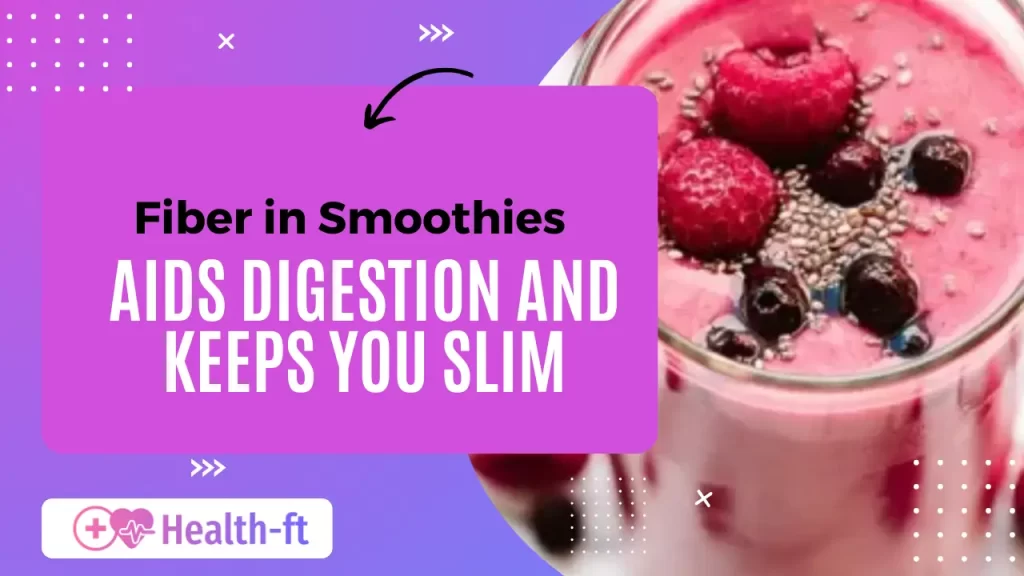Fiber is essential for digestion and plays a significant role in weight management. Adding fiber in smoothies improves gut health and keeps you full longer, making it easier to maintain a healthy weight. This guide explores how fiber supports digestion, aids weight loss, and provides practical ways to include fiber-rich smoothies in your daily routine.
What Is Fiber?
Fiber is a carbohydrate found in plant-based foods such as fruits, vegetables, grains, nuts, and seeds. Unlike other carbohydrates, fiber is not broken down by the body but passes through the digestive system, providing essential health benefits.
There are two types of dietary fiber:
-
Soluble Fiber dissolves in water, forming a gel-like substance that helps regulate blood sugar and cholesterol while promoting satiety. Foods rich in soluble fiber include oats, apples, chia seeds, and citrus fruits.
-
Insoluble Fiber – This fiber does not dissolve in water and helps move food efficiently through the digestive tract, preventing constipation. It is found in whole grains, leafy greens, and nuts.
How Fiber in Smoothies Supports Digestion?
A high-fiber diet promotes a healthy digestive system by:
-
Improving Gut Motility – Insoluble fiber adds bulk to stool, making bowel movements more regular and preventing constipation.
-
Feeding Beneficial Gut Bacteria – Soluble fiber acts as a prebiotic, supporting the growth of good bacteria in the gut, which enhances digestion and overall health.
-
Regulating Digestion – Fiber slows down nutrient absorption, particularly sugar and fat, preventing blood sugar spikes and keeping energy levels stable.
-
Preventing Digestive Disorders – A fiber-rich diet lowers the risk of digestive issues such as irritable bowel syndrome (IBS), diverticulitis, and haemorrhoids.
How Fiber in Smoothies Help with Weight Loss?
Fiber is a powerful tool for weight loss as it helps control hunger, calorie intake, and fat metabolism, making it an essential component of effective weight loss smoothies. Here’s how:
-
Enhances Satiety – High-fiber foods take longer to digest, keeping you full for extended periods and reducing overeating.
-
Reduces Caloric Density – Fiber-rich foods are lower in calories but provide volume, helping you eat less while staying satisfied.
-
Balances Blood Sugar – Soluble fiber reduces sugar absorption, preventing energy crashes and unnecessary cravings.
-
Promotes Fat Loss – Improved digestion and metabolism help the body burn fat more efficiently while reducing bloating and water retention.
What Are The Best Fiber-Rich Ingredients for Smoothies?
To maximize the benefits of fiber in smoothies, include these high-fiber ingredients:
Fruits
-
Berries – Blueberries, raspberries, and strawberries are packed with fiber and antioxidants.
-
Bananas – A medium banana contains around 3 grams of fiber, adding both nutrition and natural sweetness.
-
Apples and Pears – These fruits are rich in soluble fiber, especially when consumed with the skin.
Vegetables
-
Spinach and Kale – Leafy greens provide fiber and essential vitamins.
-
Carrots and Beets – These root vegetables add natural sweetness and fiber.
-
Zucchini – A low-calorie vegetable that enhances smoothie texture while providing fiber.
Seeds and Nuts
-
Chia Seeds – Just one tablespoon contains around 5 grams of fiber.
-
Flaxseeds – A great source of soluble fiber and omega-3 fatty acids.
-
Almonds and Walnuts – Offer fiber, protein, and healthy fats smoothie for a well-balanced.
Grains and Legumes
-
Oats – Rolled oats make smoothies creamy while adding a good amount of fiber.
-
Quinoa – A protein-rich grain that enhances fiber content.
-
Beans – Black beans or chickpeas can be blended into smoothies for an extra fiber boost.
Other Additions
-
Avocado – Provides fiber and healthy fats for a creamy smoothie texture.
-
Coconut Flakes – Add fiber and a subtle crunch.
-
Cocoa Powder – A flavorful addition with fiber and antioxidants.
What Are The Delicious Fiber-Rich Smoothie Recipes?
Berry Blast Smoothie
A refreshing, antioxidant-rich smoothie packed with fiber.
Ingredients:
-
1 cup mixed berries (blueberries, raspberries, strawberries)
-
½ banana
-
1 tablespoon chia seeds
-
1 cup almond milk
-
1 teaspoon honey (optional)
Instructions:
-
Add all ingredients to a blender.
-
Blend until smooth and creamy.
-
Pour into a glass and enjoy immediately.
Green Gut Booster Smoothie
A nutrient-dense smoothie that supports digestion and gut health.
Ingredients:
-
1 cup spinach
-
½ cucumber
-
½ apple (with skin)
-
1 tablespoon flaxseeds
-
1 cup water or coconut water
Instructions:
-
Combine all ingredients in a blender.
-
Blend until well combined and smooth.
-
Serve fresh and enjoy.
Tropical Fiber Delight Smoothie
A creamy, tropical smoothie loaded with fiber and healthy fats.
Ingredients:
-
½ mango
-
½ pineapple
-
½ avocado
-
1 tablespoon unsweetened coconut flakes
-
1 cup coconut milk
Instructions:
-
Place all ingredients into a blender.
-
Blend until smooth and creamy.
-
Pour into a glass and enjoy a tropical treat.
Oatmeal Breakfast Smoothie
A filling smoothie perfect for a fiber-rich start to the day.
Ingredients:
-
¼ cup rolled oats
-
½ banana
-
1 tablespoon almond butter
-
½ cup Greek yogurt
-
½ cup water or milk
Instructions:
-
Add all ingredients to a blender.
-
Blend until smooth and well-mixed.
-
Serve immediately and enjoy a satisfying breakfast.
What Are The Tips for Maximizing Fiber in Smoothies?
To get the most out of fiber in smoothies, keep these tips in mind:
-
Blend Whole Ingredients – Avoid peeling fruits and vegetables unnecessarily to retain fiber.
-
Start Slow – If you’re not used to a high-fiber diet, gradually increase fiber intake to prevent digestive discomfort.
-
Stay Hydrated – Drink plenty of water to help fiber move smoothly through the digestive system.
-
Experiment with Combinations – Try different fiber sources to keep smoothies exciting and nutrient-rich.
-
Track Your Intake – Aim for at least 25-30 grams of fiber daily for optimal health.
What is the Scientific Research on Fiber and Weight Management
Studies consistently highlight the importance of fiber for digestion and weight loss:
-
A study published in Obesity found that increased fiber intake led to greater weight loss when combined with a calorie-controlled diet.
-
Research in Nature showed that a diverse fiber intake promotes gut health and reduces obesity risk.
-
The American Journal of Clinical Nutrition findings suggest that soluble fiber helps regulate hunger hormones and prevents overeating.
What Are The Common Myths About Fiber in Smoothies
Myth: Too much fiber makes smoothies thick and unappetizing.
Fact: Proper blending techniques ensure smooth consistency, even with fiber-rich ingredients.
Myth: You need multiple smoothies daily to meet fiber requirements.
Fact: A single fiber-packed smoothie can contribute significantly to your daily fiber intake.
Myth: Fiber is only beneficial for digestion.
Fact: Fiber also supports weight loss, heart health, and blood sugar regulation.
Conclusion
Adding fiber in smoothies is a simple and effective way to support digestion, control hunger, and maintain a healthy weight. By selecting high-fiber ingredients and following delicious recipes, you can enjoy the benefits of fiber while keeping your smoothies both nutritious and satisfying.
Start incorporating fiber-rich smoothies into your daily routine and experience long-term health benefits with every sip!




